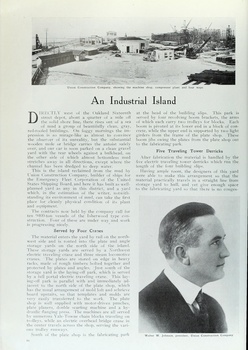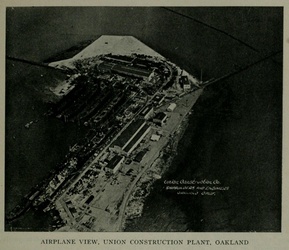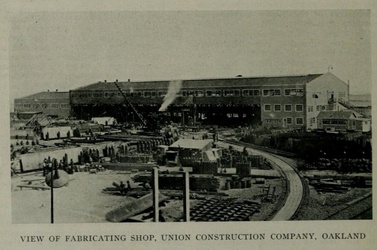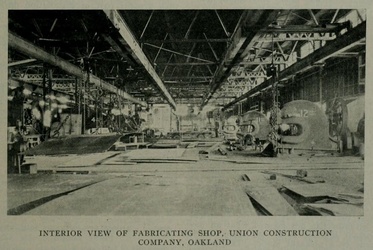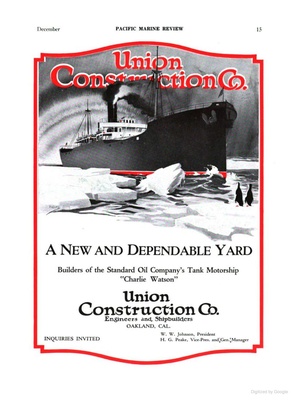 probably the Shawnee in Nov. 1921 1
probably the Shawnee in Nov. 1921 1
The Union Construction Company (UCC) was a shipbuilding yard just south of where the Bay Bridge toll plaza is now. They also did steel for construction and bridges. 30,31 Walter W. Johnson of Berkeley was president. 10 Construction was completed in 1919 2 and two ships were launched later that year; its last ship was launched just a few years later in 1923. 3 A fire all but destroyed the shipyard in 1924, 29 but the yard continued to be used for some refits, and for dismantling ships as late as 1930. 7
At the time of its construction, it was on a small peninsula of filled land, 4 but plans were already underway to fill more of the area which became the Oakland Army Base.
Pacific Marine Review, April 1919
 1918 map excerpt
1918 map excerpt 1925 map excerpt
1925 map excerpt c.1920 4
c.1920 4
 1921 ad 31
1921 ad 31 1922 ad 32
1922 ad 32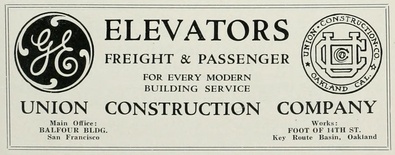 1923 ad
1923 ad
Photos from July 1921 Architect and Engineer. 30
Gold Dredges
One unusual specialty and interest of Walter W. Johnson was the construction of gold dredges. 32 Up until WWI and the increased need for merchant shipping, the company had been a partnership between Johnson and Harry G. Peake, and focused on building gold dredges. According to one of his descendants, Johnson built approximately 60 dredges, and formed dozens of companies over the years to operate them.
Several of the dredges still exist, and are on the National Register of Historic Places, including the Tuolumne Gold Dredging Company Dredge. See the Alaska Mining Hall of Fame page on Walter W. Johnson for more information.
Ships
The first 10 ships built at the UCC shipyard were cargo ships for the U.S. Shipping Board. They also built fuel tankers for a number of oil companies, and 5 ships for the U.S. Coast Guard. 3
 Pacific Marine Review November 1919
Pacific Marine Review November 1919
NOTE: For a ship's construction, there are generally 3 dates that are recorded: keel laid, hull launched, and commissioned. The hull launch was the most dramatic and was often photographed, but the ship was generally still a long way from being ready. For example, the Tampa was launched in April 1921, but wasn't commissioned until September 1921.
Tanker Charlie Watson
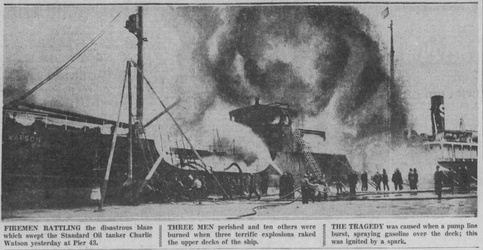 1931 explosion 13
1931 explosion 13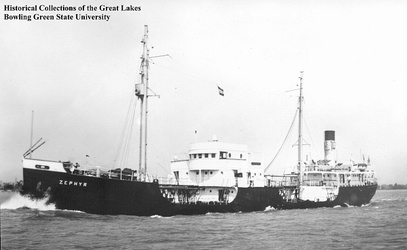 on the Great Lakes as the Zephyr 17
on the Great Lakes as the Zephyr 17
The tanker Charlie Watson was built and launched in 1920 for Standard Oil Company. 3
The ship appears in the shipping news with arrivals and departures over the years. But she made headlines up and down the coast in 1931, when a fireball exploded as the crew was unloading fuel in San Francisco at Pier 43. Five crew members were killed and 9 injured. Many were thrown into the bay by the explosions. The captain, Oscar Landahl of Berkeley, was badly injured and not expected to survive; 12,13 he succumbed to his injuries on December 7, 1931. 14
Despite the damage and sinking at the pier, the Charlie Watson was salvaged and later reconditioned. It continued plying the Pacific coast until 1939, when it was sold to Buckeye Tankers of Cleveland, Ohio. 15 Renamed the Zephyr, she was pressed into service during WWII, then returned to duty as a regular tanker following the war. She was scrapped in 1948. 16
Tampa-class cutters
 USCGC Tampa, 1921 5
USCGC Tampa, 1921 5 Tampa class, 1921 16
Tampa class, 1921 16
Four Tampa-class cutters were built at Union Construction for the U.S. Coast Guard. Each was 240' long and propelled by an electric motor, capable of speeds of 15.5 knots. 5 The sister ships of the USCGC Tampa were the USCGC Haida, the USCGC Modoc, and the USCGC Mojave. 3
The Tampa was launched in 1921. 6 The ship wasn't ready until September, and the crew members of the Tampa were upset because they had to live on a dilapidated scow while the ship was completed. 8
The Tampa was involved in the 1934 rescue of the SS Morro Castle, an ocean liner returning from Cuba. The captain of the Morro Castle died, a fire broke out, and rescue attempts were hindered by a raging storm. 137 people died.
In 1941, the Tampa was transferred to the U.S. Navy for wartime service. She performed convoy escort duty in the north Atlantic. The Modoc played a small role in the sinking of the German battleship Bismarck. The crew of the Modoc spotted the Bismarck while rescuing survivors of convoy attacks. This allowed the pursuing forces to find, disable, and eventually sink the Bismarck.
Following the end of the war, the Tampa, Modoc, and Mojave resumed ice patrols in the north Atlantic. 5
USCGC Tug Shawnee
 USCGC Shawnee, 1925 21
USCGC Shawnee, 1925 21
courtesy Coast Guard Tug Association
The tug Shawnee was launched November 15, 1921, 18 and commissioned March 8, 1922. 19 Often referred to as a cutter in newspapers, she was smaller than the Tampa class cutters at 900 tons displacement and 158' long. In addition to search and rescue duties along the West Coast, during Prohibition the Shawnee also patrolled for rumrunning ships trying to smuggle alcohol into the U.S.
But in 1923, Captain H.F. Howell may have been overzealous regarding the involvement of the Shawnee. He hastily arranged a meeting of officials in Monterey and informed them "I have been sent on a cruise to all coast ports to pass the warning to municipalities to get busy or the federal authorities will step in. I am making no specific charges or threats, but conditions must change." The local Prohibition Director, S.F. Rutter, replied that "I know nothing officially of the Coast Guard cutter Shawnee's visit to Monterey or the reported address of Captain Howell there, but it is well understood that the Coast Guard service has nothing to do with prohibition enforcement except for the detection of rum runners and smugglers." 20
After some frustration with the rumrunners being warned by radio every time the Shawnee left port, in 1924 they captured the heavily-laden Quadra with an estimated $1,000,000 in illicit booze aboard. The ship was British-flagged, and the captain immediately placed his case with the British Consul. 22,23 The captain maintained that he was more than the treaty-specified 12 miles from the coast and therefore the seizure was illegal. 24 But the case went to trial, with 30 defendants including the directors of the steamship company that owned the Quadra. 25 The trial went on, and included two crew of the Shawnee testifying for the defense, disputing their own captain and crew's testimony and records of the Quadra's position at the time of the encounter. Eventually 2 defendants plead guilty, and 8 more were found guilty during the trial. The conviction was appealed, but the court upheld the convictions. 26
The two crew members who testified for the defense, Jacob Schybinger and J.J. Dodson, were charged with perjury. They then promptly disappeared. 27 Two years later, Schybinger was captured and was being transported from Milwaukee back to the Bay Area. He was apparently depending on attorney Kenneth M. Greene to defend him, and upon learning that Greene had died, Schybinger snuck off the train near Berkeley and disappeared. 28
1924 Fire
A fire in April 1924 all but destroyed the shipyard, burning the joiner shop and the machine shop. Several people were injured, and one of the fire engines damaged when the flames jumped to it. A number of company-owned trucks were also destroyed in the fire. 29 That article also says the wood in the interior of the USS Rhode Island was burned out by the fire, but that had happened in a separate fire in January.
The source of the fire was under investigation, but fighting it was hindered by an odd set of circumstances. The alarm came in at 5:06 PM, and the shipyard's own fire crew sprang into action, with 3 big, electrically-powered pumps. They were beginning to get the fire under control, but power was cut by the Great Western Power Company at 5:15 PM, and the pumps shut down. 29 According to Johnson's descendants, the power company trouble man had showed up at the gate, but was kept out by the guards. Not knowing the situation inside, he cut the power which shut down the pumps. This led to the the fire chief issuing passes to the power company trouble men.
The fire chief later announced that investigation suggested the fire was caused by either defective wiring or spontaneous combustion.
Coal to Oil
In 1925, the company showed off a demonstration plant that used low pressure distillation to extract oil and gas from coal. The plant was purchased by R. Takata, dismantled and taken to Japan for demonstration work. 33
Closure
Although the last known ship was launched in 1923, the Union Construction Company yard was used until at least 1930 7 for the breaking up of old ships, and some refits as well. The Bear of Oakland was there for refits in 1929.
In November 1933, the port announced it was canceling the lease because there had been no shipbuilding happening. Following the 1924 fire, $68,000 in insurance money was placed in a trust, to invest in infrastructure for a new tenant, but none was found. In December 1933, UCC surrendered possession of the 67 acres it had been leasing from the port. 34,35 A 1934 article refers to reconstruction and repair work done at the "former Union Construction plant". 9
Links and References
- Solving Photo Mysteries by @DavidGallagher
- OpenSFHistory / wnp71.0326 OpenSFHistory.org
- News of the Shipyards Oakland Tribune November 19, 1918
- Union Construction Company shipbuildinghistory.com
- 2010.174.450 by Stanley H. Page, SFO Museum Aviation Collection
- USCGC Tampa (WPG-48) on Wikipedia
- First of Four Revenue Craft To Be Launched Oakland Tribune April 16, 1921
- Veteran Is To Be Broken Up For Scrap Oakland Tribune April 1, 1930
- 60 Sailors Assigned to Leaky Scow Oakland Tribune September 4, 1921
- SERA Funds to Carry Out Work on Waterfront Oakland Tribune September 14, 1934
- Walter Johnson Rites Tomorrow Oakland Tribune April 4, 1971
- ad Pacific Marine Review December 1920
- 3 Killed, Many Hurt As Gas Tanker Blows Up at Wharf in S.F. Oakland Tribune November 20, 1931 (p2)
- 4 Dead, 9 Injured In Blast and Fire at Pier 43 San Francisco Examiner November 21, 1931 (p2)
- Blast Burns Fatal to Tanker Captain San Francisco Examiner December 8, 1931
- Old Tanker Sails to Home on Lake Erie Los Angeles Times January 9, 1940
- OpenSFHistory / wnp71.0328 OpenSFHistory.org
- Charlie Watson Historical Collection of the Great Lakes Bowling Green University
- Cutter Shawnee To Be Launched Tuesday Oakland Tribune November 10, 1921
- Shawnee, 1922 United States Coast Guard
- Revenue Cutter Captain Helps Dry Enforcement Oakland Tribune January 4, 1923
- Coast Guard Tug History Coast Guard Tug Association
- Rum Loaded Ship Taken in Harbor, 30 Arrested Chico Enterprise October 13, 1924
- Heavily Laden Booze Ship Captured Visalia Daily Times October 13, 1924
- Treaty Issue Raised in Rum Ship Seizure San Francisco Examiner October 24, 1924
- Quadra Trial To Open Today San Francisco Examiner March 10, 1925
- Uphold Convictions in Quadra Trials Bakersfield Morning Echo January 5, 1926
- Two Witnesses in Quadra Rum Trial Disappear Oakland Tribune April 28, 1925
- U.S. Prisoner Leaps From Moving Train San Francisco Examiner May 19, 1927
- Authorities Probe Ship Plant Fire Oakland Tribune April 25, 1924 (p2)
- Union Construction Company Enters Building Field for Structural Steel Architect and Engineer July 1921
- ad Architect and Engineer June 1921
- ad Architect and Engineer May 1922
- Oakland Man Gets Gas, Oil From Coal Oakland Post Enquirer December 18, 1926
- Port Lease Cancelled Oakland Post Enquirer November 7, 1933
- Leased Land Surrendered Oakland Tribune December 5, 1933
- New S.F. Bay Bridge Plan Considered Oakland Tribune October 7, 1921 (p2)
- Union Construction Activities Pacific Marine Review August 1920
- New Coast Guard Cutters Pacific Marine Review October 1920
For further research
- HDC1648 (SAFR 23387) San Francisco Maritime National Historical Park (blueprints and related materials)
- BANC PIC 2001.071--PIC UC Berkeley Bancroft Library (~150 photographic prints)
- P94-023 (SAFR 23265) San Francisco Maritime National Historical Park (pass for launch in May 1919)


